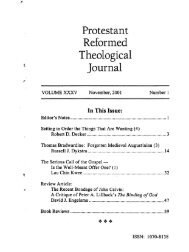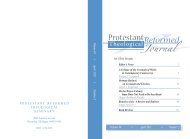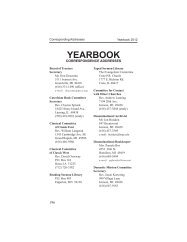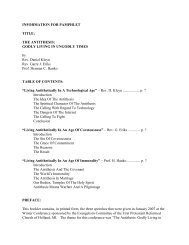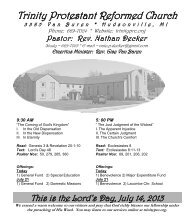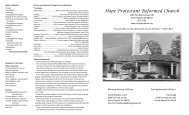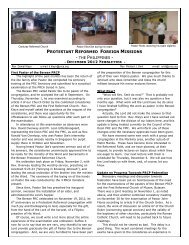November 2007 - Protestant Reformed Churches in America
November 2007 - Protestant Reformed Churches in America
November 2007 - Protestant Reformed Churches in America
Create successful ePaper yourself
Turn your PDF publications into a flip-book with our unique Google optimized e-Paper software.
Book Reviews<br />
draws out elements of the pa<strong>in</strong>t<strong>in</strong>g<br />
and the symbolism attached derstand August<strong>in</strong>e, and the Au-<br />
reformers did not correctly un-<br />
to various elements <strong>in</strong> the pa<strong>in</strong>t<strong>in</strong>g<br />
<strong>in</strong> order to describe the vari-<br />
was not the real August<strong>in</strong>e.<br />
gust<strong>in</strong>e to which they returned<br />
ous aspects of the doctr<strong>in</strong>e of The ma<strong>in</strong> purpose of God<br />
the Tr<strong>in</strong>ity. The chapter confirms<br />
Eastern Orthodoxy’s com-<br />
ecumenism by rally<strong>in</strong>g around<br />
the Holy Tr<strong>in</strong>ity is to promote<br />
mitment to iconography—dumb the most fundamental doctr<strong>in</strong>e<br />
images rather than the lively of all, the doctr<strong>in</strong>e of the Tr<strong>in</strong>ity.<br />
In fact, God the Holy Tr<strong>in</strong>-<br />
preach<strong>in</strong>g of God’s Word.<br />
Ellen T. Charry’s chapter is ity is ecumenism with a vengeance.<br />
At the outset, <strong>in</strong> his “In-<br />
marred by mis<strong>in</strong>terpretation and<br />
misrepresentation of August<strong>in</strong>e. troduction,” editor Timothy<br />
She contends that accord<strong>in</strong>g to George, while recogniz<strong>in</strong>g the<br />
August<strong>in</strong>e the “… cross is decisive<br />
because it lures us <strong>in</strong>to that exist between the various<br />
serious theological differences<br />
the beauty, wisdom, and goodness<br />
of God, <strong>in</strong> which we par-<br />
recognize one another as broth-<br />
contributors, avers that “we do<br />
take because we reflect the Tr<strong>in</strong>ity<br />
itself” (p. 137). “For Augus-<br />
and we stand together <strong>in</strong> our<br />
ers and sisters <strong>in</strong> Jesus Christ,<br />
t<strong>in</strong>e, salvation is a therapeutic commitment to the historic<br />
process of psychological and Tr<strong>in</strong>itarian faith of the church”<br />
moral transformation that requires<br />
tak<strong>in</strong>g knowledge about least. That <strong>Protestant</strong>s are will-<br />
(p. 13). Troubl<strong>in</strong>g, to say the<br />
God learned from Scripture and <strong>in</strong>g to regard adherents of Eastern<br />
Orthodoxy and Roman Ca-<br />
apply<strong>in</strong>g it to oneself” (p. 138).<br />
She faults <strong>Protestant</strong>ism for diverg<strong>in</strong>g<br />
from August<strong>in</strong>e. Espe-<br />
<strong>in</strong> Christ defies explanation. No<br />
tholicism as brothers and sisters<br />
cially is this so because “<strong>Protestant</strong>ism<br />
separated justifica-<br />
Reformation creeds can possi-<br />
<strong>Protestant</strong> who subscribes to the<br />
tion from sanctification, identify<strong>in</strong>g<br />
salvation with the former whom the creeds identify as<br />
bly have that regard for those<br />
and consider<strong>in</strong>g the latter the members of the false church.<br />
appropriate grateful response to No one who takes Rome seriously,<br />
Rome who today is not a<br />
justification…” (p. 140). So<br />
much for the Reformation’s recovery<br />
of August<strong>in</strong>ianism. In the Reformation, can possibly<br />
whit different from the Rome of<br />
Charry’s op<strong>in</strong>ion, the <strong>Protestant</strong> regard Rome’s members, to say<br />
<strong>November</strong> <strong>2007</strong> 103



